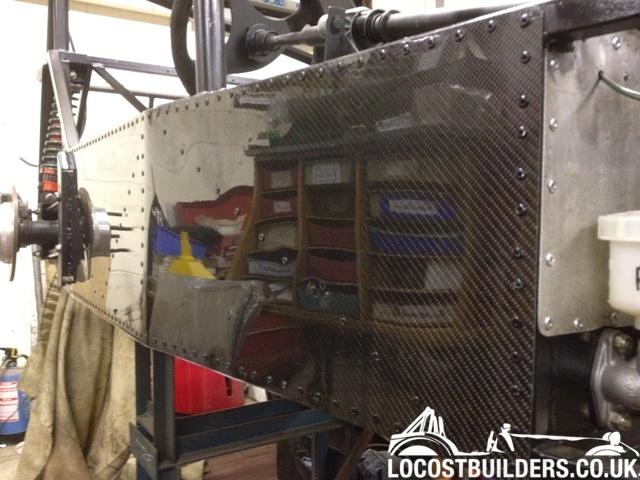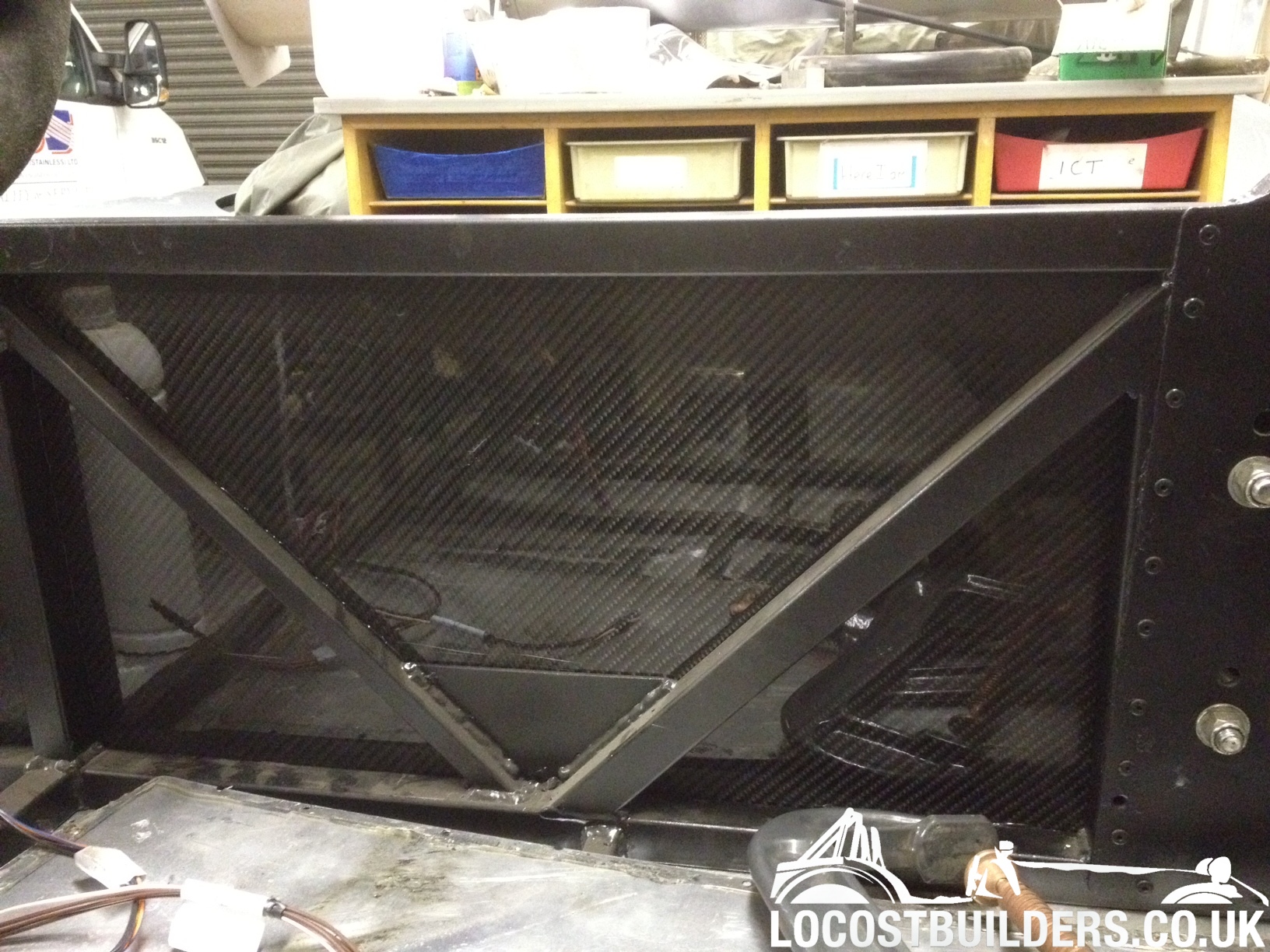
Chassis Panels & Adhesives
scootz - 16/1/12 at 09:58 AM
I suspect that 'sealing' the panels will be some kind of IVA requirement (?), but assuming you were to build a car for track / race use, or
simply refurbishing a registered car... would you choose to seal the ali chassis panels with an adhesive and then rivet, or would you forego the
adhesive and just rivet them on!?
I only ask as I've removed the old (sealed) panels from a number of cars now and it's an absolute PITA... and invariably leads to scoring
the chassis!
[Edited on 16/1/12 by scootz]
Irony - 16/1/12 at 10:06 AM
I removed the panels on my car and it was a PITA. I was planning on putting them back on with sikaflex and rivets but I know that at some point I
will want them off again. Would it be possible to use some sort of self adhesive rubber trim along the straight lengths and just sikaflex into the
corners???
welderman - 16/1/12 at 10:15 AM
QUOTE
I only ask as I've removed the old (sealed) panels from a number of cars now and it's an absolute PITA... and invariably leads to scoring
the chassis!
Dont i know it lol
[Edited on 16/1/12 by welderman]
wylliezx9r - 16/1/12 at 10:27 AM
Didn't fit any sealent on mine and rivnutted them on, no problems so far. I guess you could use double sided tape in lieu of the sealent.
wilkingj - 16/1/12 at 10:32 AM
I have always been under the impression that the point of bonding the panels to the chassis is to give added strength to the overall construction.
Luego definately told me this was what should be done. Sikaflex by choice, or any similar bonding goo. eg Tigerseal
http://www.paints4u.com/pdffiles/tigerdata.pdf
But NOT Bathroom type silicone goo.
It performs the function of helping to maxmimze the ridgitiy of the chassis.
Would you want your Kit to be built to a lower standard / strength?
IMHO Its definately BOND & RIVET

loggyboy - 16/1/12 at 10:42 AM
No IVA requirement as far as im aware.
I use sikaflex on mine, did it to water proof the internal space (I know its open top) but didnt want road spray etc working its way into the car, and
also in to the chassis and rotting it.
Interstingly Martin at Raw said not to bother!
[Edited on 16/1/12 by loggyboy]
rost - 16/1/12 at 10:45 AM
2nd on the strengthening here!
The rivets will loose strength over time and might even break at some point. Adding sealant will increase strength, but also durability.
Irony - 16/1/12 at 10:47 AM
I heard somewhere on Locostbuilders that the ally panels give the chassis extra rigidity and stiffness. Thats why some folks have gone for the
Honeycomb ally panels apparently. They are supposed to add strength and rigidity.
l0rd - 16/1/12 at 10:49 AM
what about mastic?
The rubbery seal you have on doorcards?
scootz - 16/1/12 at 10:50 AM
quote:
Originally posted by wylliezx9r
Didn't fit any sealent on mine and rivnutted them on, no problems so far. I guess you could use double sided tape in lieu of the sealent.
Rivnuts?
Do you have any pics of the finished article?
scootz - 16/1/12 at 10:51 AM
quote:
Originally posted by welderman
QUOTE
I only ask as I've removed the old (sealed) panels from a number of cars now and it's an absolute PITA... and invariably leads to scoring
the chassis!
Dont i know it lol
Soz! 
Chippy - 16/1/12 at 10:56 AM
Using some form of mastic, of whatever type, not only adds strength, but also forms a barrier between the steel chassis and the ally panels to stop
electrolasis, (sp), between disimilar metals. So as far as I am aware that makes it an absolute essential. IMHO Ray
welderman - 16/1/12 at 01:14 PM
quote:
Originally posted by scootz
quote:
Originally posted by welderman
QUOTE
I only ask as I've removed the old (sealed) panels from a number of cars now and it's an absolute PITA... and invariably leads to scoring
the chassis!
Dont i know it lol
Soz! 
No bother mate, its all part of the fun, and when you start ending up with panels like this, im happy.
picture taken with my phone so its not perfect, (nearly mind)
[img] [/img]
[/img]

Also to add, panel is bonded and rivited
[Edited on 16/1/12 by welderman]
scootz - 16/1/12 at 01:19 PM

Bare - 16/1/12 at 05:06 PM
IMO an utter waste to add Glue Goo, V much like wearing double Condoms.
Apply some seam seal if water ingression is your perceived problem.
Although in 12 years of owning a Series 3 Seven, it was Never a problem I experienced.
As stated it makes a horrid mess if one needs to remove a panel.
[Edited on 16/1/12 by Bare]
scootz - 16/1/12 at 05:28 PM
I seem to recall that the Caterham I had a few years back didn't have any sealant under the panels!
Angel Acevedo - 23/1/12 at 10:27 PM
I used 3M Double sided tape to fix a Moulding that goes between the hood and attaches to the windshield on a Pickup truck and it was pretty solid, it
may be easier to remove than Sikaflex or the like, but may be what you are looking for.
HTH
AA
ashg - 23/1/12 at 11:02 PM
quote:
Originally posted by welderman
quote:
Originally posted by scootz
quote:
Originally posted by welderman
QUOTE
I only ask as I've removed the old (sealed) panels from a number of cars now and it's an absolute PITA... and invariably leads to scoring
the chassis!
Dont i know it lol
Soz! 
No bother mate, its all part of the fun, and when you start ending up with panels like this, im happy.
picture taken with my phone so its not perfect, (nearly mind)
[img] [/img]
[/img]

Also to add, panel is bonded and rivited
[Edited on 16/1/12 by welderman]
joe you really should put a not safe for work title up if your planning on posting up porn 
Peteff - 24/1/12 at 09:57 AM
Get some sticky backed Velcro and fit them with that, they should come off easily then 
TimC - 24/1/12 at 10:33 AM
Fair-play Joe, that is going to look Uber-schweet when finished.
Steve Hignett - 24/1/12 at 11:00 AM
quote:
Originally posted by TimC
Fair-play Joe, that is going to look Uber-schweet when finished.
It bloody well should!!!
welderman - 24/1/12 at 01:43 PM
Thanks for comments boys, heres the inside of same panel
[img] [/img]
[/img]
Neville Jones - 25/1/12 at 04:01 PM
With all that carbon, I'd be putting some small zinc pieces well connected to the chassis, at various points around the chassis. Sacrificial
anodes.
Cheers,
Nev.
RK - 2/2/12 at 12:38 PM
A bit OT, but how on earth do people get that nice, shiny surface when doing CF? Mine always have bumps and rough bits, no matter how much wax I put
down, and how much I polish ahead of time. And I've done it on glass as well as ally and plastic/polycarbonate. The best was from ally and glass
with no wax or release agent. Could it be temperature isn't high enough? I've seen all the videos and I see nice, shiny, smooth parts coming
out of the moulds. But this just is not my reality!!
ps wet lay, wrapped in plastic after. Don't seem to get an excess of resin.
[Edited on 2/2/12 by RK]
jacko - 2/2/12 at 05:14 PM
If you look at new buses the panels are only sika-flexed on apart from four 1/8 pop rivets in the corners
guess how i know
jacko
Liam - 2/2/12 at 05:40 PM
quote:
Originally posted by jacko
If you look at new buses the panels are only sika-flexed on apart from four 1/8 pop rivets in the corners
guess how i know
jacko
It's the future! Well actually the present and recent past too  . I used 3M VHB tape for all my panels and bugger all rivets. Used to stick
busses and trains together among other things. A couple of inches bond on 1" RHS is strong enough to support my weight. The tape's foam
carrier gives a nice 'dead' thud when you tap a panel - no rattling. I put a few rivets in corners to resist peel of the panels. Certainly
saves perforating your chassis with hundreds of rivet holes. A few pics of the joyously simple and satisfying process in my archive.
. I used 3M VHB tape for all my panels and bugger all rivets. Used to stick
busses and trains together among other things. A couple of inches bond on 1" RHS is strong enough to support my weight. The tape's foam
carrier gives a nice 'dead' thud when you tap a panel - no rattling. I put a few rivets in corners to resist peel of the panels. Certainly
saves perforating your chassis with hundreds of rivet holes. A few pics of the joyously simple and satisfying process in my archive.
Benonymous - 3/2/12 at 03:40 AM
RK, the glassy surface you see on some composite panels comes from not only having a polished surface against the layup but also a way of compressing
the layup onto the shiny surface. The most practical way to do this is vacuum bagging. On some of the parts I've made, I got a lot of pinholes
in the weave so I just painted on a layer of slow curing epoxy. If you put it on nice and even, all the brush marks will flow out of the resin and
leave a decent looking flat surface which can be buffed up to anice shine.




 [/img]
[/img]